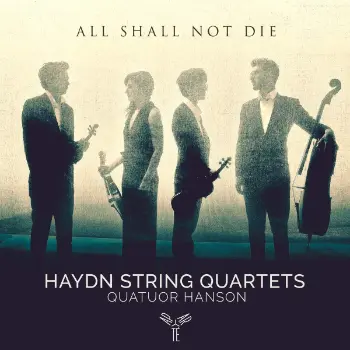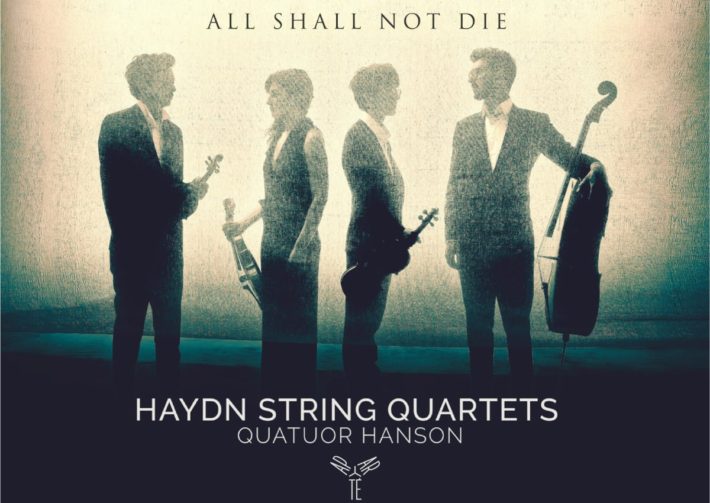Making their recording debut on Aparté, with an album entitled, ‘All Shall Not Die’, Quatuor Hanson focus on the string quartets of ‘Papa Haydn’, with whom they consider themselves to have a particular affinity. Taking a potpourri of six diversely interesting quartets from a range of opus numbers, they give a colourful snapshot of Haydn’s whimsical, yet inventive compositional approach.

These demonstrate the structural and textural developments from the early String Quartet op.20 no.5 of the ‘sun’ quartets (1772) to op.77 no.2 of the ‘Lobkowitz’ set from 1799 (Prince Lobkowitz, who commissioned the op.77 set, also commissioned Beethoven’s op.18 set at approximately the same date). This program of quartets is not chronological, but thoughtfully ordered to contrast keys, moods and colours. The mix of popular and lesser-known works reveals Quatuor Hanson’s deep understanding of Haydn and an ability to curate an exceptional journey.
From the outset, multiple things impress; the sound — both from the quartet and the recorded quality; the vibrancy of their interpretation; the unity of their playing, and their technical assurance with flawless intonation. Op 50. no.6, which opens the album, reveals their faithfulness to Haydn’s score. Aided by a natural interplay and an ability to bring out the humour across all four movements reveal they have a clear vision for the entire piece. Their ending of the first movement leaves one in the air, pondering, thus bringing out the intrinsic Haydn, whilst the third Minuet has some unexpected, but stylistic embellishments added to the repeats.
Following on is the celebrated “Fifths” Quartet, Op.76 no.2, very different in colour and texturally contrasts with its more dominant 1st violin role. Repeats are handled with further creativity and sensitivity. The Minuet having a less dance quality but more of a reminiscent beauty. With some effective rubato, this movement evolves to reveal a strong personality. The finale has an urgency and a commanding character, the playing forceful and energetic, yet very persuasive in this considered rendition.
The final sequence is the three quartets of Op.33 no.5, Op.20 no.5 and op.77 no.2. This carefully considered selection gives a complete musical journey, with a seamless transition from one to the other. Op.77 no.2 is an absolute pleasure, full of movement and iridescent colour. Compared to the Amadeus Quartet, Quatuor Hanson brings lyricism with lighter sonorities and cleaner vibrato, a delightfully uplifting and fitting conclusion to a characterful and consistently engaging album.
The booklet accompanying this release is excellent. A welcomed and detailed program notes chart the compositional history of the quartets. Diligence has been taken to give these young artists a platform to explain their ideas and approach to period performance practice on modern instruments and other interpretative choices with regards to repeats. Where repeats are observed, they enhance the repetition with some sympathetic but creatively interesting embellishments, often taking the listener by surprise.
Recorded in Little Tribeca au Théâtre d’Arras, France, in two sessions, the instruments are recorded closely miked, clearly evident from the purity of the sound. Skilfully placed microphones have ensured this studio capture is free from blemishes and other extraneous noises. The superb balance gives a sense of perspective, the first violin to the left, cello to the right, with second violin and viola to the centre.
Quatuor Hanson raises the issue of whether everything that can be said in Haydn’s music has been said. If considering just op.76 no.2 along the lines of groups such as the Amarti, Emerson or Takács quartets, perhaps not. Whilst each quartet has its own unique sound, Quatuor Hanson comes closest to surpassing the vibrancy of the Takács. Their sound is not that of novices coming to Haydn, but of musicians who understand the structures and balance in the music, playing it with a freshness, seemingly shaped by the quartet forefathers. Whilst this music is not new, they bring a refreshing excitement and originality, packing a strong musical punch with the strength of their musical chemistry. Whether sampling or revelling in the entire album, there is much to delight and treasure.
“All Shall Not Die”
Haydn – String Quartets Op.20 no.5, Op.33 no.5 (“How do you do?”), Op.50 no.6 (“The Frog”), Op.54 no.2, op.76 no.2 (“Fifths”), op.77 no.2
Quatuor Hanson:
Anton Hanson, Jules Dussap – Violin
Gabrielle Lafait – Viola
Simon Dechambre – Cello
Aparté, CD AP213

Album Details |
|
|---|---|
| Album name | All Shall Not Die |
| Label | Aparté |
| Catalogue No. | CD AP213 |



















